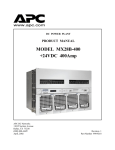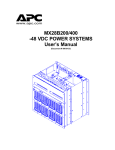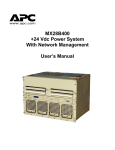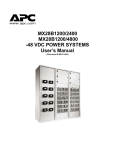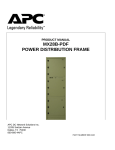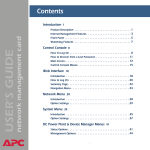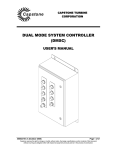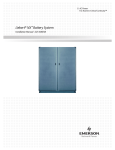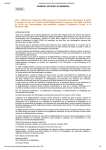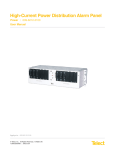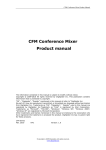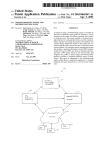Download American Power Conversion MX28B600 User's Manual
Transcript
DC Power Plant
Product Manual
MX28B600
December 2002
Part# 990-0564
APC DCNS Inc.
11035 Switzer Avenue
Dallas, TX 75238
REVISION HISTORY
Revision
Date
By
Description
07/10/01
JNF
Initial release.
10/30/02
BET
Changed breaker numbering
TABLE OF CONTENTS
1. GENERAL INFORMATION ................................................................................................1
1.1 INTRODUCTION .............................................................................................................................................1
1.2 PRECAUTIONS................................................................................................................................................1
1.3 INSPECTION UPON RECEIPT OF GOODS .....................................................................................................1
1.3.1 General ................................................................................................................................................1
1.3.2 Visible External Damage .................................................................................................................1
1.3.3 Concealed Damage ...........................................................................................................................2
1.3.4 Return of Damaged Goods ..............................................................................................................2
2. CUSTOMER SERVICE AND SUPPORT ................................................................3
3.
WARRANTY PROVISIONS ............................................................................................................................4
3.1 GENERAL PROVISIONS .................................................................................................................................4
3.1.1 Warranty Returns ..............................................................................................................................4
3.1.2 Warranty Repair or Replacement ..................................................................................................4
3.2 EXCLUSIONS AND LIMITATIONS .................................................................................................................4
4. PRODUCT OVERVIEW AND TECHNICAL DESCRIPTION .........6
4.1
4.2
4.3
4.4
4.5
4.6
4.7
4.8
4.9
4.10
4.11
DESCRIPTION .................................................................................................................................................6
POWER OUTPUT CAPACITY.........................................................................................................................8
RECTIFIERS ....................................................................................................................................................8
CONTROL UNIT .............................................................................................................................................8
AC INPUT POWER ........................................................................................................................................9
BATTERY CONNECTIONS .............................................................................................................................9
DC DISTRIBUTION .....................................................................................................................................10
MOUNTING ..................................................................................................................................................10
ENVIRONMENTAL .......................................................................................................................................10
MECHANICAL ..............................................................................................................................................11
COMPLIANCE ...............................................................................................................................................11
5. INSTALLATION PROCEDURES ................................................................................12
5.1 PREPARATION..............................................................................................................................................12
5.1.1 Recommended Tools .......................................................................................................................12
5.1.2 Recommended Test Equipment .....................................................................................................12
5.1.3 Equipment Inspection .....................................................................................................................12
5.1.4 Safety Precautions ...........................................................................................................................12
5.1.5 Room/Locations ...............................................................................................................................12
5.1.6 Mounting ...........................................................................................................................................13
5.1.7 Ventilation .........................................................................................................................................13
5.2 AC SERVICE AND GROUND CONNECTIONS ...........................................................................................13
5.3
BATTERY CONNECTIONS ................................................................................................................................13
5.3.1 Cable Sizing Considerations .........................................................................................................14
5.3.2 Connecting the Cables....................................................................................................................14
5.4 DC SYSTEM GROUNDING ................................................................................................................14
5.5 RECTIFIER INSTALLATION .........................................................................................................................14
5.6 ALARM CONNECTIONS ..............................................................................................................................14
5.6.1 External Alarm Inputs ....................................................................................................................15
5.6.2 Alarm Outputs ..................................................................................................................................16
5.7 CONNECTING THE LOADS .........................................................................................................................16
5.7.1 DC Circuit Breakers and Fuses ...................................................................................................16
MX28B600
5.7.2 Installation of Circuit Breakers and Fuses ................................................................................18
5.7.2.1 Plug-in Circuit Breakers .................................................................................................................. 18
5.7.2.2 Optional GMT Fuses ........................................................................................................................ 18
5.7.3 Load Connections ............................................................................................................................19
5.7.3.1 Circuit Breakers .................................................................................................................................. 19
5.7.3.2 Optional GMT Fuses ........................................................................................................................ 19
5.8 BATTERY TEMPERATURE PROBE INSTALLATION ..................................................................................19
5.9 POWER-UP AND CHECKOUT .....................................................................................................................19
5.9.1 Apply AC Power ..............................................................................................................................20
5.9.2 System Parameters Verification/Adjustment .............................................................................20
5.9.3 Full System Power Up ....................................................................................................................20
6. SETUP, ADJUSTMENTS, AND OPERATION................................................22
6.1
6.2
6.3
6.4
6.5
USER INTERFACE ........................................................................................................................................22
SNMP INTERFACE .....................................................................................................................................22
EXTERNAL ALARM INPUTS .......................................................................................................................23
ALARM OUTPUT RELAYS ..........................................................................................................................23
PARAMETER LOCATIONS, DESCRIPTIONS, AND DEFAULT VALUES ...................................................23
- ii -
MX28B600
1. GENERAL INFORMATION
1.1 Introduction
DC Power Plants from APC DC Network Solutions Inc. (hereafter in this document “APC”)
have unique features that make them easy to install, maintain, and upgrade. The rectifier units
are modular and truly “hot-pluggable” into the shelf assembly without any separate AC wiring.
All system settings are made from the system control unit that provides monitoring and control
functions for each component of the system as well as alarm listings for system diagnosis and
maintenance.
The APC’s international network of sales and service offices and qualified representatives
provides sales assistance for proposals, purchases, and after-sales support.
APC provides nationwide support 8am to 8pm EST. 8pm to 8am Emergencies only by
leaving a message with a paging system by dialing:
(800) 800-4APC
This service will answer your call, gather specific service information, and have a qualified APC
service representative contact you as quickly as possible (refer to section on customer service
and support).
1.2 Precautions
It is extremely important to read, understand, and strictly follow the instructions in
sections on installation and setup. Also, please note the special SAFETY PRECAUTIONS
outlined in Section 5.1.4 before beginning actual installation of the power system.
If any precautions are not clearly understood, or local conditions are not covered, contact the
nearest APC representative call us at 800-800-4APC for clarification.
Also, refer to all applicable federal, state, and local regulations, and industry guidelines for
correct installation of this power system.
1.3 Inspection upon Receipt of Goods
1.3.1 General
APC has taken precautions in packing the power equipment for shipment to ensure its safe
arrival; however, the entire shipment including any and all boxes or crates should be inspected
upon receipt for evidence of damage that may have occurred during transit.
1.3.2 Visible External Damage
It is the responsibility of the person receiving the shipment to inventory and inspect all materials
against the bill of lading or waybill provided IMMEDIATELY upon taking delivery while the
carrier representative is STILL ON SITE. Please be sure that all items are accounted for,
including the correct number of pallets and the quantity of all accessory and/or component
boxes. Also, note any visible external damage that may have occurred during transit.
If damage has occurred or the quantity of items is not correct, then:
-1-
MX28B600
1) Make a descriptive notation on the delivery receipt before signing.
2) File a damage or shortage report with the carrier that delivered the shipment.
1.3.3 Concealed Damage
It is the customer’s responsibility to unpack the power system and equipment received from
APC and check for concealed damage, within 15 days of receipt of any and all materials. The
customer is responsible to check the materials received against the detailed packing list to verify
that the quantity and condition are complete and satisfactory.
Again, note any damage to the internal packing material, the equipment itself, and/or material or
equipment shortages. If damage or shortage is noted, then:
1) Immediately request an inspection by the carrier;
2) File a concealed damage claim; and/or
3) File a material shortage claim with your APC representative.
DELAY IN NOTIFYING THE CARRIER MAY RESULT IN LOSS OF RIGHT TO
REIMBURSEMENT FOR DAMAGES OR LOSS.
If you are unsure about the appearance of a part while conducting the materials inventory and
inspection, refer to the manual or contact the Customer Service Department of APC.
Should you have any questions concerning potential damages or should you experience a
lack of cooperation from your carrier, please contact your APC representative, or call
APC.
1.3.4 Return of Damaged Goods
Should equipment be damaged and require return to APC for repair, the APC service
representative will provide instructions along with a valid returned material authorization
(RMA) number to facilitate return of the damaged goods to the APC repair center.
It is important that the steps outlined in Section 1.3.2 and Section 1.3.3 above are followed
carefully. Your APC representative will assist you, if required, in obtaining proper disposition
of an initial delivery return issue; however, a valid RMA number must be obtained before
returning any equipment to APC.
-2-
MX28B600
2. CUSTOMER SERVICE AND SUPPORT
APC manufactures standby power plants and systems, and provides customers with complete
product and systems support and service. APC has an international network of factory trained
service technicians. The service organization is on call 24 hours a day, 365 days a year.
If there is a problem with the power system, contact APC DCNS at
1-800-800-4APC
When you contact APC you should refer to your supplier as DC Network Solutions. Units
returned for repair can usually be turned around within 24 to 48 hours of receipt at the
factory location. Shipment should be sent pre-paid. The unit will be returned pre-paid
provided it was received that way.
An RMA must be obtained for all equipment returned to APC. It is important that correct
procedures be followed in filing an RMA, including providing an accurate written description of
the problem. An accurate written problem description will help ensure that the unit will be
properly repaired in a timely manner.
If a unit is returned and a “No Fault Found” results, APC reserves the right to bill the
customer for labor and assess a service charge to recover the costs incurred.
-3-
MX28B600
3. WARRANTY PROVISIONS
3.1 General Provisions
APC DC Network Solutions Inc. warrants the power equipment and components it manufactures
or sells against defective materials and workmanship for a period of TWO (2) YEARS from the
date of shipment.
3.1.1 Warranty Returns
If initial physical inspection results in identification of a material or workmanship flaw(s) that
could impair product performance, as defined by APC’s electrical and physical specification in
effect at the time of shipment, and if this flaw(s) is not due to transportation damage or
installation abuse, contact APC at 1-800-800-4APC, to request assistance.
You will be provided either; a) an RMA number with instructions for return of the equipment or
component(s) to the APC factory service center, FOB destination, freight pre-paid, for
examination; or b) for non-returnable systems and equipment, notice to wait until an APC
authorized service representative arrives at the site to inspect the equipment. Repaired or
advance replacement modules or circuit components will normally be available within 24 to 48
hours of receipt of returned equipment or repairs and/or equipment adjustments will be
performed by APC service representatives at the site. APC reserves the right to determine the
method for correction of equipment flaw(s).
3.1.2 Warranty Repair or Replacement
If, during the warranty period, the supplied equipment is found to be physically or electrically
faulty due to defective materials or workmanship on the part of APC, the defective product(s) or
component(s) will be repaired or replaced at the sole option of APC without charge to the user
for replacement materials or repair labor. (The procedure outlined above for contacting APC
must be followed.) Costs incurred for replacement installation including, but not limited to,
installation equipment, travel expenses of an APC representative(s), and costs for installation
material transportation expenses are not the responsibility of APC. Any replacement product(s)
or component(s) shall only complete the remaining unused portion of the original warranty of
the replaced product(s) or component(s).
3.2 Exclusions and Limitations
1. This warranty applies only to the original US domestic purchaser (user) and is not
transferable internationally, except with expressed written consent from APC.
2. APC reserves the right to void the warranty if identification marks or serial numbers have
been removed or tampered with, or the defect is determined to have been caused by misuse,
neglect, improper installation, environmental conditions, non-authorized repair, alteration, or
accident.
3. This warranty does not cover physical damage due to the acts of nature or man that stress the
equipment or component(s) beyond design limits and exert undesirable influence aside from
normal wear and tear.
4. APC assumes no responsibility for any work performed, or expenses incurred, except with
expressed written consent from APC.
-4-
MX28B600
5. APC shall not be liable to the user (purchaser), or any third party, for indirect, incidental, or
consequential damages such as, but not limited to, loss of use, loss of profits, costs
associated with removal/installation of a defective product(s) or component(s) arising out of
the sale or relating to the use of this product; and the user (purchaser) assumes all
responsibility for all personal injury and property damage resulting from the handling,
possession, or use of the product. In no event shall the liability of APC for any and all
claims, including claims of breach of warranty or negligence, exceed the purchase price of
the product that gave rise to the claim.
The above warranty is in lieu of all other remedies, including actions for contract or negligence.
All other warranties, expressed or implied, including but not limited to the implied
warranties of merchantability and fitness for a particular purpose, are hereby excluded.
-5-
MX28B600
4. PRODUCT OVERVIEW AND TECHNICAL DESCRIPTION
4.1 Description
The MX28B600 is a modular stand-alone -48V DC power plant with a microprocessor-based
control unit. It is configurable in such a manner that it will support most typical applications
within the specified current range of 600 amperes without special application engineering or
assistance. Distribution of two tiers is included for up to 44 plug-in circuit breakers, located in a
24-position panel (breakers labeled 1 to 23) and two 10-position panels (breakers labeled 25-34
and 39-48), all with front access. These circuit breakers can be 1 to 100 amps, with 60-100 amp
breakers requiring two positions and a circuit breaker adapter kit.
An optional low voltage disconnect (LVD) can be provided on either the battery or the load side.
Optional load shedding capabilities can also be provided by use of an additional LVD that will
disconnect loads connected to the lower right breaker panel at a user specified voltage.
Figure 4.1-1. MX28B600
-6-
MX28B600-48V
Figure 4.1-2. MX28B600 BLOCK DIAGRAM
7
MX28B600-48V
4.2 Power Output Capacity
600 amps maximum, or 550 amps with N+1 redundancy. The housing provides space for three
rectifier shelves that can hold up to four rectifiers each, a control unit, and two tiers of up to 43
distribution circuit breakers.
4.3 Rectifiers
The rectifiers are APC DC Network Solutions, Inc. Model MRF28H54BV with specifications as
follows:
•
Input Voltage:
176-264V AC (230V AC nominal) @ 45-66 Hz
•
Input Current per Rectifier:
13.9 Amps @ 230V AC
•
Apparent Power Factor:
99% Typical, 98% Minimum
•
Output Voltage:
54.5V DC
•
Over voltage Protection:
Set at 59.5V DC
•
Output Current per Rectifier:
50 Amps Minimum Continuous
•
Power Output per Rectifier:
2800W Continuous, Vin > 198V AC
•
Efficiency:
91% Typical
•
Cooling:
Fan cooled, front to rear airflow
•
Ambient Temperature:
-25°C to 65°C Operational
•
Hostile/Dusty Environment:
Dust filter is optional
4.4 Control Unit
The microprocessor-based power system control unit is 1U high (1.75”) and provides control
and monitoring functions. Operating features are:
•
32-character alphanumeric display
•
LED alarm and status indicators
•
Standard voltage and battery charging control
•
Battery temperature compensation (optional)
•
Monitoring of up to three shelves of four rectifiers each
•
Individual alarm monitoring of 43 breakers
•
Individual alarm monitoring of eight GMT fuses
•
Eight alarm / annunciation relays (Major, Minor, and six user defined) with form C
contact outputs
•
Four external alarm inputs (either N.O. or N.C. contacts)
•
Control of either a battery or a load LVD
•
WEB/SNMP interface card for remote monitoring.
8
MX28B600-48V
4.5 AC Input Power
Each rectifier requires 208/220/240V AC, single-phase, 50/60 Hz, supplied through an external
20-amp two-pole breaker. There are three entry points (one for each rectifier shelf), for
customer-supplied one-inch conduit. Section 5.2 for details on electrical connection.
4.6 Battery connections
Battery connections are made by feeding the cables thru the bottom-rear of the unit. Use caution
when running the cables to not damage other components. (Figure 4.6-1). The -48V and return
buses each provide two sets of threaded 3/8”-16 holes on one-inch centers for connecting twohole battery cable lugs.
A manual battery disconnect breaker is included in the equipment housing at the top right circuit
breaker position in the front panel.
Battery temperature compensation is available. APC’s standard temperature monitor sensor and
cable is used to implement this optional function.
Battery Cables
Battery
Negative (-)
Battery
Positive (+)
Figure 4.6-1. Battery Cable Connection Locations
9
MX28B600-48V
4.7 DC Distribution
Two plug-in circuit breaker tiers, consisting of a 24-position panel and two 10-position panels,
provide 43 positions of -48V distribution. One position is reserved for the Manual Battery
Disconnect Switch. The breaker tiers are center fed via bus bars to the -48V DC bus with each
side having an ampacity of 300A.
Connections for -48V DC loads, requiring standard #10-32 two-hole lugs on 5/8-inch centers,
are located directly above the corresponding breaker. The load returns connect to the return bus,
which accommodates 24 two-hole #10-32 lugs on 5/8-inch centers, and four two-hole ¼”-20
lugs on ¾-inch centers. The return bus also provides a pair of threaded 3/8”-16 holes on 1-inch
centers for connection of a cable to the master station ground. Figure 4.7-1 shows the power
plant’s DC distribution section with the front cover removed.
Eight GMT fused outputs are also available as an option, and are configured at the factory.
Figure 4.7-1. Upper Tier DC Distribution (Front Cover Removed)
4.8 Mounting
Front mounting on standard 72” or 84” high, 23-inch rails
4.9 Environmental
•
Ambient Temperature:
•
Humidity: 0% to 85% RH non-condensing operating
0% to 95% RH non-condensing storage
•
Altitude: Up to 3000m (9800Ft) operating
Up to 10,000m (32,000Ft) storage
-20°C to +65°C (-4°F to +149°F) operating
-40°C to +85°C (-40°F to +185°F) storage
10
MX28B600-48V
4.10 Mechanical
•
Dimensions:
42" high x 23" wide x 20"deep (1066x584x508mm)
•
Weight:
Housing - 190 lbs. (86kg)
Rectifier - 11 lbs each. (5kg)
•
Color: Dawn Gray (fronts)
NOTE:
Descriptions & sizes are for the power system alone; when installed with
inverters, batteries, etc., dimensions & weight will be affected.
4.11 Compliance
•
UL 1950
•
NEBS – level 3
•
FCC Part 15, Class A
11
MX28B600-48V
5. INSTALLATION PROCEDURES
5.1 Preparation
5.1.1 Recommended Tools
•
Standard selection of insulated hand tools.
•
Proper tools for crimping the selected cable lugs.
5.1.2 Recommended Test Equipment
•
Digital Multimeter
5.1.3 Equipment Inspection
Remove equipment from packing material and inspect for shipping damage to verify the safety
and operational suitability for the installation site. [Refer to Section 1.3]
5.1.4 Safety Precautions
***** WARNING *****
The MX28B600 DC power plant is supplied from a nominal 220V AC, 60 Hz source. Keep
the AC input enclosure cover in place when the system is operational or energized.
***** WARNING *****
Hazardous energy levels are present on bare conductors in the -48V DC distribution
connection area of the plant. While certain engineering precautions have been designed into
the system, accidental shorting of distribution conductors can cause arcing and high
currents that can cause serious burns or other physical harm.
It is recommended that:
•
Any jewelry, rings or watches be removed while working on this equipment.
•
Handles of all wrenches, screwdrivers, cutters and pliers be insulated.
•
Shafts of screwdrivers must be wrapped in electrical tape or otherwise insulated.
*****WARNING*****
NOTE: OVER TEMPERATURE WILL LEAD TO RECTIFIER SHUTDOWN.
Rectifier fan inlet filters are available for dusty or hostile environments. The filters
require periodic cleaning and/or replacement. Monitor filters to determine a maintenance
cycle for filter cleaning. Rectifiers will signal OVER TEMPERATURE WARNING and
eventually fail if filters are not maintained.
5.1.5 Room/Locations
NOTE: The power plant is designed for installation in a room, vault, or similar enclosure
that is accessible only to qualified persons in accordance with NEC or other
authority having jurisdiction.
12
MX28B600-48V
Prior to installation, drawings, floor loading requirements, external alarm points, AC service
entrance, and grounding schemes should all be checked and confirmed. If batteries are to be
mounted in a room separate from the power plant, careful attention should be paid to battery
cable voltage drop effects. Environmental operating temperatures and ventilation/cooling
considerations should also be noted, not just for the power system but for all other equipment
that may reside in the power room area.
5.1.6 Mounting
Front mounting on standard 23” rails, and/or installation in appropriately vented cabinets is
possible.
5.1.7 Ventilation
The rectifiers have fans that provide front to rear airflow for internal cooling. The MX28B600
housing should be installed and/or mounted such that there is free airflow to the front, top, and
bottom of the unit. [Refer to Section 4.9 for environmental characteristics.]
5.2 AC Service and Ground Connections
***** WARNING *****
Ensure that all of the DC and external AC circuit breakers are in the OFF position prior to
connecting service to the power plant. Confirm that all voltages have been removed
including any battery sources before proceeding.
The MX28B600 DC power plant requires the supply of 208/220/240V AC, single-phase, 50/60
Hz power through individual external 20-amp two-pole circuit breakers to the AC input terminal
block connections for each rectifier in the system. (The AC wiring, from the AC input terminal
block connections to the hot-pluggable AC input connector for each rectifier, is factory
installed.)
The AC input enclosure, located at the top left rear of the MX28B600 housing, is provided with
three one-inch conduit entry holes. Inside, 3 terminal strips for AC input power connection and a
separate “Earth Ground” bar for connection of the safety ground wires are provided. The
terminal blocks are labeled as Position 1 through Position 4 for shelves 1, 2, and 3 with each
position having inputs designated “L1” and “L2” for connection of the two AC wires. Positions
1-4 correspond to the respective rectifier shelf positions from left to right.
The suggested wire size is #10 AWG rated at 90°C or higher; however, the ambient temperature
and number of wires in a conduit must also be considered in accordance with NEC
requirements. It is suggested that feeds for four rectifiers (8 wires) and one safety ground wire
be run in a one-inch conduit; however, be sure to follow any local electrical wiring codes.
If the AC input power is provided from a three-phase distribution panel, the circuit breaker
positions should be selected such that the load is balanced as much as possible.
5.3 Battery Connections
An external circuit breaker or fused disconnect (Customer supplied) is recommended in the
negative line (located at the battery end of the related cables) to protect the cables from the
battery to the MX28B600 DC power plant. The power plant can monitor auxiliary contacts
from this breaker.
13
MX28B600-48V
5.3.1 Cable Sizing Considerations
The battery cable(s) should be sized sufficiently large to limit the voltage drop from the
MX28B600 DC power plant to the battery during charging in accordance with system design
requirements. The cable(s) must also carry the full load current during battery operation. If
assistance is required to determine the necessary cables for the application, contact your sales
representative or APC DC Network Solutions Inc.
5.3.2 Connecting the Cables
The battery cable connections are located at the center rear of the unit as shown in Figure 4.6-1.
The battery positive (return bus) and battery negative (-48V bus) buses each provide two sets of
threaded 3/8”-16 holes on one-inch centers for connecting two-hole battery cable lugs. Connect
the battery cables as applicable using 3/8”-16 bolts (not provided) and tighten them with a
torque wrench to 200 in-lbs.
***** CAUTION *****
Make certain that the battery polarity is correct when making connections to the
MX28B600 DC power plant. Incorrect connection could cause severe equipment damage.
5.4 DC SYSTEM GROUNDING
THE POSITIVE BATTERY CONNECTION (RETURN BUS) FOR THE POWER
PLANT MUST BE CONNECTED TO THE MASTER STATION GROUND. THE
RIGHT SIDE SECTION (when viewed from the front of the unit) OF THE RETURN BUS
PROVIDES A PAIR OF THREADED 3/8”-16 HOLES ON 1-INCH CENTERS FOR
CONNECTION OF A TWO-HOLE LUGGED CABLE TO THE MASTER STATION
GROUND. DETAILS FOR THIS CONNECTION SHOULD BE PROVIDED IN THE
SITE ELECTRICAL GROUNDING PLANS.
5.5 Rectifier Installation
The APC DC Network Solutions Inc. Model MRF28H54BV rectifiers are shipped in separate
containers. Follow the procedure below to install a rectifier.
1) Remove the rectifier from its shipping container.
2) Slide the rectifier into the shelf between the guides until it is fully seated.
3) Locate the rectifier retaining screws in the bag the manual came in.
4) Fasten the rectifier in place with the rectifier retaining screw.
Since all adjustments are made from the system control unit, no rectifier adjustments are
necessary.
NOTE: All “FLOAT” – “BOOST/EQUALISE” switches (one is located on the front of
each rectifier in the system) must be set to “FLOAT” to allow the MX28B600 to
control the output voltage properly.
5.6 Alarm Connections
The alarm connections for all rectifiers, breakers, and fuses are factory pre-wired. The
MX28B600 DC power plant, however, permits the user to program the system alarms in various
ways.
14
MX28B600-48V
Figure 5.6 Interface Board
5.6.1 External Alarm Inputs
Four external alarm inputs with assignable priority levels are available. These alarm inputs
respond to external dry contact closures between normally open (NO) and common (C) or
contact openings between normally closed (NC) and C (see Table 5.6-1).
External Alarm Source
(non-alarm state)
Connect To Input
Alarm Terminals
OPEN
CLOSED
NO-C
NC-C
Table 5.6-1. External Alarm Input Definition
Table 5.6-2 shows the external alarm input connection designations. Connector J4 is located on
the interface card mounted in the top left side of the unit. Systems are shipped with jumper
wires connecting each NC and corresponding C contact. A jumper wire should be removed only
if the corresponding NC-C contacts are going to be used.
EXTERNAL
ALARM
INPUT
J4 TERMINAL
DESIGNATION
(NO-NC-C)
USER ALARM NOTES
#1
#2
#3
#4
NO1-NC1-C1
NO2-NC2-C2
NO3-NC3-C3
NO4-NC4-C4
___________________________
___________________________
___________________________
___________________________
Table 5.6-2. External Alarm Input Connections
15
MX28B600-48V
5.6.2 Alarm Outputs
There are eight alarms available that provide outputs via Form “C” relay contacts. The last two
of these are pre-assigned as the Minor and Major alarm outputs. The Major relay is energized
(NO-C contacts closed) during normal (non-alarm) operating conditions; all the other relays
energize when an alarm condition occurs. The other six outputs are initially designated as
“Relay 1” through “Relay 6” (the user may assign more meaningful names if desired). The
various system alarm conditions can be assigned to any of the eight alarm outputs.
Table 5.6-3 shows the alarm output connection designations. Wago Connectors are located on
the interface card mounted in the top left side of the unit. The relay contacts should only be
used to switch resistive loads of 0.5 amperes or less at 60 volts or less.
ALARM
OUTPUT
TERMINAL
DESIGNATION
NO-NC-C
USER ALARM NOTES
RELAY #1
RELAY #2
RELAY #3
RELAY #4
NO1-NC1-C1
NO2-NC2-C2
NO3-NC3-C3
NO4-NC4-C4
________________________
________________________
________________________
________________________
RELAY #5
RELAY #6
MINOR
MAJOR
NO5-NC5-C5
NO6-NC6-C6
NO7-NC7-C7
NO8-NC8-C8
________________________
________________________
________________________
________________________
Table 5.6-3. Alarm Output Connections
5.7 Connecting The Loads
5.7.1 DC Circuit Breakers and Fuses
Both plug-in circuit breakers and GMT fuses can be installed in the MX28B600 power plant for
DC distribution circuit protection. Two plug-in circuit breaker tiers, consisting of a 24-position
panel (breakers labeled 1 to 24) and two 10-position panels (breakers labeled 25 to 34 and 39 to
48), provide 44 positions of -48V distribution. Available plug-in circuit breakers are shown in
table 5.7-1. Plug-in circuit breakers rated at 60A or more require two mounting positions and
require a breaker adapter kit, which is included (see kit selection information below the table).
The breaker adapter kit includes all necessary mounting hardware.
An optional load shed circuit is available. This option will disconnect any unessential loads
from the rest of the system. Loads hooked up to the lower left tier (CB 26-35) will be
disconnected. This will preserve the battery run time for essential loads. When hooking up the
loads, ensure that they are divided correctly.
16
MX28B600-48V
*
BREAKER
RATING
PART NUMBER
BREAKER
RATING
PART NUMBER
1A
FFA-0014
40 A
FFA-0020
3A
FFA-0015
50 A
FFA-0025
5A
FFA-0016
60 A
FFA-0021-X *
10 A
FFA-0017
70 A
FFA-0022-X *
15 A
FFA-0028
80 A
FFA-0023-X *
20 A
FFA-0018
100 A
FFA-0024-X *
30 A
FFA-0019
-1: adapter has #10 studs on 5/8” centers for two-hole cable lug
-2: adapter has #10 studs on ¾” centers for two-hole cable lug
-3: adapter has ¼” studs on 1” centers for two-hole cable lug
Table 5.7-1. Plug-in Circuit Breakers
A list of GMT type fuses available from APC DC Network Solutions Inc. is provided in Table
5.7-2.
FUSE RATING
PART NUMBER
1/4 A
FFA-0030
1/2 A
FFA-0031
3/4 A
FFA-0032
1A
FFA-0033
1¼ A
FFA-0039
1½ A
FFA-0035
3A
FFA-0036
5A
FFA-0037
10 A
FFA-0038
Table 5.7-2. GMT Fuses
17
MX28B600-48V
5.7.2 Installation of Circuit Breakers and Fuses
5.7.2.1 Plug-in Circuit Breakers
1) Remove the circuit breaker cover panel and the plastic cover(s)/insert(s) from the
desired location(s).
2) Install the circuit breaker(s) by snapping the top terminal onto the upper bus bar and
rotating the unit down until the second terminal snaps onto the breaker termination
post as shown in Figure 5.7-1. The breaker alarm terminals are designed to make
contact with the alarm terminal board as the breaker is snapped into place.
NOTE: Circuit breaker alarm contacts close when the circuit breaker is tripped
but not when it is turned OFF.
***** CAUTION
*****
During circuit breaker installation, carefully align the breaker alarm terminals with the
alarm terminal board to avoid breaker terminal damage.
3) Reattach the circuit breaker cover panel.
Figure 5.7-1. Installation of Circuit Breakers
5.7.2.2 Optional GMT Fuses
Fuseholders that accommodate GMT fuses are located on the interface card mounted in the top
left side of the unit. These fuseholders are only connected to -48V DC if the system has been
purchased with the GMT fuse option. This option supplies -48V DC to the fuseholders through
18
MX28B600-48V
a 50 A. circuit breaker located in circuit breaker Position 1. The interface card provides
fuseholders for eight fuses, labeled “F1” through “F8”, which can be used for small -48V DC
loads. The maximum fuse size that should be used is 10A.
5.7.3 Load Connections
5.7.3.1 Circuit Breakers
Connections for -48V DC loads require standard two-hole lugs for #10 screws on 5/8” centers
and are located directly above the corresponding circuit breaker. The load returns connect to the
respective return bus located just above and rearward of the breaker connection points. The
upper tier is seen in Figure 4.7-1. The return buses provide a total of 40 sets of threaded #10-32
holes on 5/8” centers and four sets of threaded ¼”-20 holes on ¾” centers for connection of twohole lugs on load return wires.
5.7.3.2 Optional GMT Fuses
Connections to the GMT fuses are made at terminal block connectors labeled “F1” through “F8”
that are located on the interface card mounted in the top left side of the unit. Each connector has
two positions, labeled “-48V” and “RTN”, for connection of the -48V DC load and load return
wires.
5.8 Battery Temperature Probe Installation
The optional temperature probe is used to monitor the battery string temperature. To get the
most representative temperature measurement, the probe should be placed in contact with a
battery cell that is centrally located. The probe should be placed directly in contact with the cell
(not the frame surrounding the cell). Generally, the cell cover can be used; be careful not to
allow the probe body to touch the terminals.
1) Plug the connector end of the temperature
probe into J5 the control unit backplane
card.
2) Route the cable as required to position the
probe on the selected battery cell
3) Remove the adhesive protection strip from the probe body and press the
adhesive side of the probe on the battery cell cover.
J5
5.9 Power-Up and Checkout
Before initiating power-up and checkout, ensure that the following conditions exist:
1) Make sure that the external circuit breaker protecting the cables from the battery to
the power plant is turned OFF (the battery cables should be connected to the power
plant, but the battery should not be connected).
2) Make sure that all load circuit breakers are turned OFF (including the one feeding the
GMT fuses if the unit has the GMT fuse option).
3) Verify that all rectifiers have been installed.
19
MX28B600-48V
5.9.1 Apply AC Power
Turn on the circuit breakers that supply AC power to the rectifiers in the MX28B600 DC power
plant. The main screen should appear on the control unit display (see Figure 5.9-1). The display
on the control unit is a 2-lines by 16-characters display. The cursor cycles below the characters
of the active selection on the display. Information shown in the second line of Figure 5.9-1 that
extends beyond 16 characters (to the right of the “S” in “ALARMS”) can viewed on the control
unit display by using the scrolling controls (refer to Section 6 for operation of the control unit).
NOTE: When AC power is initially applied, there is a 60-second period during which no alarms
are reported.
MX28B600
+
STATUS ALARMS SYSTEM MODULES BATT PIN OEM
Figure 5.9-1
5.9.2 System Parameters Verification/Adjustment
The MX28B600 system control unit is delivered with pre-programmed parameter default
settings. A complete listing and description of all system configuration parameters as well as
displayable system status and information is provided in Section 6. Read Section 6 to gain an
understanding of and how to use the operational features provided by the MX28B600 DC power
plant. As a minimum, the following parameters should be verified and adjusted, if required,
before connecting batteries or loads to the power plant:
1) Battery Float Voltage - default = -54.00V DC (Check the manufacturer’s
recommendation for the batteries being used in the system.)
2) Battery Maximum Recharge Rate - default = 50A. (Bellcore specifications
recommend a maximum charging rate of capacity (in Ampere-hours) divided by 20
hours; check the battery manufacturer’s recommendation.)
3) System Voltage - measurement ≅ -54.00V DC (This is a measurement by the system of
the DC output bus voltage.)
4) LVD Option - default = “Enable” (If the MX28B600 does not have an LVD installed,
this should be changed to “Disable”.)
5) Rectifier Information - Check the rectifier information displays to verify that all
rectifiers installed can be viewed on the control unit display and that no rectifier alarms
are active.
Section 6 provides location information for these parameters and how to make changes if
required.
5.9.3 Full System Power Up
To complete a full system power up, perform the following steps
1) Turn OFF all the circuit breakers that supply AC power to the rectifiers in the
MX28B600 DC power plant.
2) Turn on the external circuit breaker from the battery to the power plant.
20
MX28B600-48V
3) Turn on all the circuit breakers that supply AC power to the rectifiers in the MX28B600
DC power plant.
4) Load circuit breakers may now be turned on as required.
21
MX28B600-48V
6. SETUP, ADJUSTMENTS, AND OPERATION
6.1 User Interface
The MX28B600 control unit provides a user interface designed with a hierarchical menu that
can be viewed on the 32-character display by “navigating” with the “Õ” (left), “Ö” (right), “×”
(up), and “Ø” (down) arrow keys located on the front panel. The selected item on the display is
identified by the cursor cycling beneath its characters.
The “M” (modify) key and the arrow keys are used to set parameters and text to customize the
system operation for a specific application. Items that can be modified have "m+" in the upper
right corner of the display. (If a security level higher than the one presently set is required to
modify the parameter, "s+" is displayed instead of “m+”.) Status, alarms, and information
screens have "+" in the upper right corner of the display (or “#” in the case of rectifier
information screens) and cannot be modified. When AC power is initially applied, there is a 60second period during which no alarms are reported.
Pressing the "M" key on the front panel will change the "m+" to "M+", indicating that the
parameter can now be changed using the arrow keys. Some parameters can be changed to other
predefined selections by pressing the up or down arrow keys to display an alternative selection.
These parameters can be recognized after the “M” key is pressed by the cursor cycling beneath
the characters of the selection. For other parameters, such as text and most numeric values, after
the “M” key is pressed the cursor will be displayed under an individual character. The right or
left arrow key is used to position the cursor below the character to be changed and the up or
down arrow key is used to "spin" the digit or letter to the desired value. When the desired
changes have been made to an individual parameter screen, the “M” key is pressed again; the
“M+” changes back to “m+” and the new entry is stored in memory.
If the user plans to make any changes to system parameters, the first item that should be verified
or entered is the appropriate password for the security level required for the parameters to be
modified. Security level 2 enables modification of all variable system parameters, level 1
permits modification of some parameters; no security is required for viewing status items. The
security level password is entered through the “PIN” screen. If no front panel keys are pressed
for 60 minutes, the active password reverts to “0000” and “█APC█” begins to move about the
display. Pressing any key returns the display to normal; the password must be re-entered if
system parameters require changes.
Eleven LEDs are provided on the front panel of the control unit to indicate system status. Three
LEDs grouped together vertically provide overall system status; they are “MAJOR”, “MINOR”,
and “NORMAL”, indicating the presence of a major alarm, a minor alarm, or normal operation.
The other eight LEDs correspond to the active state of each of the alarm output relays and are
labeled “ALM1”∙∙∙“ALM6”, “MIN”, and “MAJ”.
6.2 SNMP interface
In addition, the unit’s controller incorporates a 10-base T Ethernet connection to allow remote
access to the system signals, and remote control of certain aspects of its operation. APC’s
Manual #991-0181 in the form of a CDRom will allow users to set up interface with the user’s
Information Technology System. Simple Network Management Protocol (SNMP) version 1 is
supported along with telnet protocol.
22
MX28B600-48V
6.3 External Alarm Inputs
The four external alarm inputs (also referred to as “Input Relay Alarms”) can be assigned a
priority and routed or “mapped” to alarm output relays. Available assignments are “Ignore”,
“Major”, “Minor”, and “Relay 1” ∙∙∙ “Relay 6”. Screens for making the assignments are
located at [SYSTEM/IN-RLY/RLY-MAP]. A user defined name or “alias” may also be
assigned to each of these input alarms. Screens for making these assignments are located at
[SYSTEM/IN-RLY/ALIAS]. For information on wiring connections to these inputs refer to
Section 5.6.1.
6.4 Alarm Output Relays
There are eight alarm output relays designated Relay 1 through Relay 6, Minor, and Major,
respectively. Various system parameters may be programmed to activate any of these alarm
relays when set thresholds are exceeded or specific conditions occur. The first six relays can
also be assigned a priority and routed or “mapped” to other output alarm relays. Available
assignments are “Ignore”, “Major”, “Minor”, and “Relay 1” ∙∙∙ “Relay 6”. Screens for making
these assignments are located at [SYSTEM/OUT-RLY/RLY-MAP]. This feature makes it
possible for a single alarm condition to activate multiple alarm output relays including the Minor
or Major alarm relay. A user defined name or “alias” may also be assigned to each of the eight
output relay alarms. Screens for making these assignments are located at [SYSTEM/OUTRLY/ALIAS]. For information on making wiring connections to the alarm output relays refer
to Section 5.6.2.
6.5 Parameter Locations, Descriptions, and Default Values
The location, description, and factory programmed default value for each of the MX28B600
system parameters is found in The table also shows all of the status and information screens
with typical displays. The location of a parameter screen is shown in brackets, for example:
[SYSTEM/IN-RLY/RLY-MAP]. To find the parameters that can be accessed in this category,
starting from the main menu screen, do the following:
1) Use the right or left arrow keys to position the cycling cursor below “SYSTEM”.
2) Press the down arrow key once.
3) Use the right arrow key to position the cycling cursor below “IN-RLY”.
4) Press the down arrow key once; the cursor will be cycling below “RLY-MAP”.
5) Press the down arrow key (repeatedly if necessary) until the desired parameter screen is
displayed (there are eight parameter screens in this category).
6) After making any desired changes (refer to Section 6.1 for the procedure), to return to the
main menu press the up arrow key repeatedly.
If a parameter requires a level 1 or level 2 security access to permit changes to it, the security
level will be found in braces, i.e. {2}, in the “PARAMETER” column of table 6.4.1.
The complete menu structure shown in the order in which it is accessed from the control unit
display is presented in outline form in figure 6.4-1 Each indentation to the right represents a
menu level below the indicated title.
23
MX28B600-48V
Table 6.5-1. Parameter Locations, Descriptions, and Default Values
PARAMETER
DESCRIPTION
DISPLAY SCREENS /
DEFAULT SETTINGS
SYSTEM SETUP
Password Entry
Screen for entry of the active password (PIN).
PIN
m+
0000
Level 1 PIN {2}
[SYSTEM/SETUP]
Password (PIN) that permits security Level 1 parameter
changes - limited access.
PIN 1
m+
1111
Level 2 Password {2}
[SYSTEM/SETUP]
Password (PIN) that permits security Level 2 parameter
changes - unlimited access.
PIN 2
m+
2222
OEM R Offset {2}
[OEM]
Voltage offset adjustment for factory calibration of voltage
readings/settings.
OEM R Offset m+
0.000 V
OEM R Gain {2}
[OEM]
Voltage gain adjustment for factory calibration of voltage
readings/settings.
OEM R Gain
m+
1.000 V
OEM S Offset {2}
[OEM]
Current offset adjustment for factory calibration of battery
current readings/settings.
OEM S Offset m+
0.0 A
OEM S Gain {2}
[OEM]
Current gain adjustment for factory calibration of battery
current readings/settings.
OEM S Gain
m+
1.000 A
Address 1 {1}
[SYSTEM/SETUP]
Power plant address or identification - first line.
Address 1
APC
Address 2 {1}
[SYSTEM/SETUP]
Power plant address or identification - second line.
Address 2
m+
11035 Switzer Av
Address 3 {1}
[SYSTEM/SETUP]
Power plant address or identification - third line.
Address 3
Dallas, TX.
m+
Model {2}
[SYSTEM/SETUP]
Model name for the DC power plant. “reset defaults”
selection will re-initialize to factory settings for model
selected
Model
MX28B600
m+
Temperature Scale {1}
[SYSTEM/SETUP]
Enables selection of Fahrenheit or Celsius temperature scale
(Fahrenheit “OFF” displays readings in °C).
Fahrenheit
Control Unit Revision
[SYSTEM/SETUP]
Hardware revision level of the control unit.
Cntrl Rev
+
000002
Firmware Version
[SYSTEM/SETUP]
Version number of the control unit firmware.
NOTE: Actual firmware version number displayed is the
current version as of the date of manufacture.
FW Version
+
000131
PIN Entry
[PIN]
Password Setup
OEM Calibration
Site Address/Identification
m+
Control Unit Setup & Info.
m+
OFF
24
MX28B600-48V
(Table 6.5-1. Parameter Locations, Descriptions, and Default Values)
PARAMETER
DESCRIPTION
DISPLAY SCREENS /
DEFAULT SETTINGS
Type number for the control unit display.
Display Type
+
000255
Date {1}
[SYSTEM/DATE]
Internal system calendar date.
Date
m+
JUN 27 2001
Time {1}
[SYSTEM/DATE]
Internal system clock time (24-hour format).
Time
High Voltage Threshold {1}
[SYSTEM/SET-ALM]
System High voltage alarm threshold.
Sys HV Thr
m+
-58.00 V
Low Voltage Threshold {1}
[SYSTEM/SET-ALM]
System Low voltage alarm threshold.
Sys LV Thr
m+
-50.00 V
High Temperature Threshold {1}
[SYSTEM/SET-ALM]
Over temperature alarm threshold.
Sys HT Thr
m+
70.0 C
Low Temperature Threshold {1}
[SYSTEM/SET-ALM]
Under temperature alarm threshold.
Sys LT Thr
System Voltage
[STATUS]
System output voltage measured between the MX28B DC
power plant -48V and return buses.
Sys Voltage
+
-54.00 V
System Current
[STATUS]
The total system output current (calculated as the sum of the
individual rectifier output currents).
Sys Current
+
445.8 A
System Temperature
[STATUS]
System temperature measured within the control unit.
Sys Temp
Battery Current
[STATUS]
Battery current measured at the current shunt. Will display
negative current when Batt is charging, Positive current
when Batt is discharging.
Batt Current
+
-15.0 A
Battery Temperature
[STATUS]
Battery temperature measured by the optional battery
temperature sensor probe. NOTE: Will read about –156° C
with no probe attached
Batt Temp
System High Voltage {1}
[SYSTEM/SET-ALM]
System voltage is above the high voltage threshold.
Sys HV Alm
m+
Minor
System Low Voltage {1}
[SYSTEM/SET-ALM]
System voltage is below the low-voltage threshold.
Sys LV Alm
m+
Minor
System High Temperature {1}
[SYSTEM/SET-ALM]
The control unit temperature is above the high temperature
threshold.
Sys HT Alm
m+
Minor
Display Type
[SYSTEM/SETUP]
Date/Time Setup
m+
9:00:25
Alarm Threshold Setup
m+
0.0 C
System Status
+
26.7 C
+
25.2 C
System Alarms
25
MX28B600-48V
(Table 6.5-1. Parameter Locations, Descriptions, and Default Values)
PARAMETER
Test Relay 1 {1}
[SYSTEM/DIAG]
•
•
•
DESCRIPTION
Setting this parameter to “ON” energizes Relay 1 and turns
on the “ALM1” LED on the control unit front panel.
DISPLAY SCREENS /
DEFAULT SETTINGS
Test Relay 1 m+
OFF
•
•
•
•
•
•
Test Relay 6 {1}
[SYSTEM/DIAG]
Setting this parameter to “ON” energizes Relay 6 and turns
on the “ALM6” LED on the control unit front panel.
Test Relay 6 m+
OFF
Test Minor Relay {1}
[SYSTEM/DIAG]
Setting this parameter to “ON” energizes the Minor Relay
and turns on the “MIN” LED on the control unit front panel.
Test Min Rly m+
OFF
Test Major Relay {1}
[SYSTEM/DIAG]
Setting this parameter to “ON” de-energizes the Major Relay
and turns on the “MAJ” LED on the control unit front panel.
Test Maj Rly m+
OFF
Float Voltage {1}
[BATT/PARAM]
Float voltage at 25°C battery temperature.
Batt Float
m+
-54.00 V
Maximum Recharge Current {1}
[BATT/PARAM]
Maximum battery recharge current (the system limits the
charging current to this programmable value).
Batt Max Rech m+
50 A
Compensation Method {1}
[BATT/COMP]
Activate “000001” or de-activate “000000” battery
temperature compensation.
Comp Method
m+
000000
Temperature Compensation {1}
[BATT/COMP]
Temperature compensation between low knee and high knee
in mV/cell/°C. (Compensation equals zero at 25°C.)
Comp TC
Compensation High Knee {1}
[BATT/COMP]
The temperature compensation high knee is the point above
which there is no additional battery voltage compensation for
further increases in temperature.
Comp Hknee
m+
40.0 C
Compensation Low Knee {1}
[BATT/COMP]
The temperature compensation low knee is the point below
which there is no additional battery voltage compensation for
further decreases in temperature.
Comp Lknee
Discharge Threshold {1}
[BATT/SET-ALM]
An alarm is generated if the battery discharge current exceeds
this value.
Batt Disc Thr m+
10 A
High Voltage Threshold {1}
[BATT/SET-ALM]
An alarm is generated if the magnitude of the battery voltage
rises above this value.
Batt HV Thr
m+
-58.00 V
Low Voltage Threshold {1}
[BATT/SET-ALM]
An alarm is generated if the magnitude of the battery voltage
drops below this value.
Batt LV Thr
m+
-44.00 V
High Temperature Threshold {1}
[BATT/SET-ALM]
An alarm is generated if the battery temperature exceeds this
value.
Batt HT Thr
m+
70.0 C
Low Temperature Threshold {1}
[BATT/SET-ALM]
An alarm is generated if the battery temperature drops below
this value.
Batt LT Thr
m+
0.0 C
BATTERY SETUP
m+
- 3.00mV
m+
0.0 C
26
MX28B600-48V
(Table 6.5-1. Parameter Locations, Descriptions, and Default Values)
PARAMETER
DESCRIPTION
DISPLAY SCREENS /
DEFAULT SETTINGS
Battery Alarms
Discharge Alarm {1}
[BATT/SET-ALM]
An alarm that is generated if the battery discharge current
exceeds the programmed battery discharge threshold.
Batt Disc Alm m+
Minor
High Voltage Alarm {1}
[BATT/SET-ALM]
An alarm that is generated if the magnitude of the battery
voltage rises above the high voltage threshold.
Batt HV Alm
m+
Minor
Low Voltage Alarm {1}
[BATT/SET-ALM]
An alarm that is generated if the magnitude of the battery
voltage drops below the low voltage threshold.
Batt LV Alm
m+
Minor
High Temperature Alarm {1}
[BATT/SET-ALM]
An alarm that is generated if the battery temperature exceeds
the high temperature threshold.
Batt HT Alm
m+
Minor
Low Temperature Alarm {1}
[BATT/SET-ALM]
An alarm that is generated if the battery temperature drops
below the low temperature threshold.
Batt LT Alm
m+
Minor
Fail Safe Voltage {1}
[MODULES/RECT/PARAM]
Rectifier default output voltage if communication with the
control unit fails.
Rect Fail Safem+
-54.00 V
Communications Timeout {1}
[MODULES/RECT/PARAM]
The maximum rectifier communications response time
allowed before a communications failure is declared.
Rect Fail Commm+
1 min
RECTIFIER SETUP
Rectifier Information
NOTE: This information can be viewed for each rectifier
installed by using the horizontal arrow keys.
Rectifier Current
[MODULES/RECT/INFO]
A display of the DC output current for the individual
rectifier.
Rect 1 Curr
#
24.9 A
Current Limit Alarm
[MODULES/RECT/INFO]
The status will be “ON” if the rectifier has been forced into
its current limited mode.
Rect 1 CL
Standby Alarm
[MODULES/RECT/INFO]
The status will be “ON” if the control unit is holding the
rectifier in the standby mode.
Rect 1 Stdby
#
OFF
Fan Fail Alarm
[MODULES/RECT/INFO]
The status will be “ON” if the rectifier fan has failed.
Rect 1 FF
Rectifier Fault Alarm (RFA)
[MODULES/RECT/INFO]
The status will be on if the rectifier output has failed.
#
OFF
#
OFF
Rect 1 RFA
OFF
#
Rectifier Alarms
Current Limit Alarm {1}
[MODULES/RECT/SET-ALM]
This alarm indicates that a rectifier has been forced into the
current limited mode.
Rect CL Alm
m+
n of N
27
MX28B600-48V
(Table 6.5-1. Parameter Locations, Descriptions, and Default Values)
PARAMETER
DESCRIPTION
DISPLAY SCREENS /
DEFAULT SETTINGS
Standby Alarm {1}
[MODULES/RECT/SET-ALM]
This alarm indicates that the control unit is holding a rectifier
in the standby mode.
Rect Stdby Almm+
n of N
Fan Fail Alarm {1}
[MODULES/RECT/SET-ALM]
This alarm indicates that a rectifier fan has failed.
Rect FF Alm
m+
n of N
RFA Alarm {1}
[MODULES/RECT/SET-ALM]
This alarm indicates that a rectifier output has failed.
Rect RFA Alm m+
n of N
An alternate name (alias) that can be assigned to a circuit
breaker if desired.
Cir Bkr 1
-48V
CIRCUIT BREAKER SETUP
Breaker 1 Alias {1}
[MODULES/CIRBKR/ALIAS]
•
•
•
Breaker 48 Alias {1}
[MODULES/CIRBKR/ALIAS]
•
•
•
m+
•
•
•
An alternate name (alias) that can be assigned to a circuit
breaker if desired.
Cir Bkr 48
-48V
m+
An alarm that indicates Circuit Breaker 1 is tripped.
Cir Bkr 1 Alm m+
Major
Circuit Breaker Alarms
Breaker 1 Tripped {1}
[MODULES/CIRBKR/SET-ALM]
•
•
•
Breaker 48 Tripped {1}
[MODULES/CIRBKR/SET-ALM]
•
•
•
•
•
•
An alarm that indicates Circuit Breaker 24 is tripped.
Cir Bkr 48 Almm+
Major
An alternate name (alias) that can be assigned to a Fuse 1 if
desired.
FUSE 1
-48V
FUSE SETUP
Fuse 1 Alias {1}
[MODULES/FUSE/ALIAS]
•
•
•
Fuse 16 Alias {1}
[MODULES/FUSE/ALIAS]
•
•
•
An alternate name (alias) that can be assigned to a Fuse 16 if
desired.
+
•
•
•
FUSE 16
+
-48V
28
MX28B600-48V
(Table 6.5-1. Parameter Locations, Descriptions, and Default Values)
PARAMETER
DESCRIPTION
DISPLAY SCREENS /
DEFAULT SETTINGS
FUSE Fuse Alarms
Fuse 1 Blown {1}
[MODULES/FUSE/SET-ALM]
•
•
•
Fuse 16 Blown {1}
[MODULES/FUSE/SET-ALM]
An alarm that indicates Fuse 1 is blown.
•
•
•
FUSE 1 Alm
m+
Major
•
•
•
An alarm that indicates Fuse 16 is blown.
FUSE 16 Alm
m+
Major
An alternate name (alias) can be assigned to the relay if
desired.
In-Rly 1
m+
Input Relay 1
INPUT RELAY SETUP
Input Relay 1 Alias {1}
[SYSTEM/IN-RLY/ALIAS]
•
•
•
Input Relay 4 Alias {1}
[SYSTEM/IN-RLY/ALIAS]
•
•
•
•
•
•
An alternate name (alias) can be assigned to the relay if
desired.
In-Rly 4
m+
Input Relay 4
An alarm activated in response to an external contact closure
or opening at the Input Relay 1 connection.
In-Rly 1 Alm m+
Ignore
•
•
•
•
•
•
An alarm activated in response to an external contact closure
or opening at the Input Relay 4 connection.
In-Rly 4 Alm m+
Ignore
An alternate name (alias) can be assigned to the relay if
desired.
Out-Rly 1
Relay 1
Input Relay Alarms
Input Relay 1 {1}
[SYSTEM/IN-RLY/RLY-MAP]
•
•
•
Input Relay 4 {1}
[SYSTEM/IN-RLY/RLY-MAP]
OUTPUT RELAY SETUP
Output Relay 1 Alias {1}
[SYSTEM/OUT-RLY/ALIAS]
•
•
•
•
•
•
m+
•
•
•
Output Relay 6 Alias {1}
[SYSTEM/OUT-RLY/ALIAS]
An alternate name (alias) can be assigned to the relay if
desired.
Out-Rly 6
Relay 6
m+
Output Relay Minor Alias {1}
[SYSTEM/OUT-RLY/ALIAS]
An alternate name (alias) can be assigned to the relay if
desired.
Relay Minor
Minor
m+
29
MX28B600-48V
(Table 6.5-1. Parameter Locations, Descriptions, and Default Values)
PARAMETER
DESCRIPTION
DISPLAY SCREENS /
DEFAULT SETTINGS
Output Relay Major Alias {1}
[SYSTEM/OUT-RLY/ALIAS]
An alternate name (alias) can be assigned to the relay if
desired.
Relay Major
m+
Major
Output Relay 1 Delay {1}
[SYSTEM/OUT-RLY/RLY-MAP]
Delay between sensing of the alarm condition and activation
of the alarm relay. An alarm condition must exist for longer
than the delay to be activated.
Out-Rly 1 Dly m+
0 sec
•
•
•
Output Relay 6 Delay {1}
[SYSTEM/OUT-RLY/RLY-MAP]
•
•
•
•
•
•
Delay between sensing of the alarm condition and activation
of the alarm relay. An alarm condition must exist for longer
than the delay to be activated.
Out-Rly 6 Dly m+
0 sec
Output Relay 1 alarm can be “mapped” to activate other
output relays (“Ignore” activates no additional relays).
Out-Rly 1 Alm m+
Ignore
Output Relay Alarms
Output Relay 1 {1}
[SYSTEM/OUT-RLY/RLY-MAP]
•
•
•
•
•
•
•
•
•
Output Relay 6 alarm can be “mapped” to activate other
output relays (“Ignore” activates no additional relays).
Out-Rly 6 Alm m+
Ignore
LVD1 Trip {1}
[MODULES/LVD/PARAM]
LVD1 trip (disconnect) threshold voltage.
LVD1 Trip
m+
-42.00 V
LVD1 Restore {1}
[MODULES/LVD/PARAM]
LVD1 restore (reconnect) threshold voltage.
LVD1 Reset
m+
-48.00 V
LVD2 Trip {1}
[MODULES/LVD/PARAM]
LVD2 trip (disconnect) threshold voltage.
LVD2 Trip
m+
-42.00 V
LVD2 Restore {1}
[MODULES/LVD/PARAM]
LVD2 restore (reconnect) threshold voltage.
LVD2 Reset
m+
-48.00 V
LVD1 Option {1}
[MODULES/LVD/SET-ALM]
Set to “Enable” if the unit has an LVD1.
LVD1
LVD1 Alarm {1}
[MODULES/LVD/SET-ALM]
Sets the priority or “mapping” of an LVD1 Alarm.
LVD1 Open Alm m+
Minor
LVD2 Option {1}
[MODULES/LVD/SET-ALM]
Set to “Enable” if the unit has an LVD2.
LVD2
LVD2 Alarm {1}
[MODULES/LVD/SET-ALM]
Sets the priority or “mapping” of an LVD2 Alarm.
LVD2 Open Alm m+
Minor
Output Relay 6 {1}
[SYSTEM/OUT-RLY/RLY-MAP]
LVD SETUP
LVD Alarm
Option m+
Enable
Option m+
Enable
30
MX28B600-48V
31
MX28B600-48V
Figure 6.4-1. Control Unit Menu Structure
MX28B600
+
STATUS
Sys Voltage
Sys Current
Sys Temp
Batt Current
Batt Temp
ALARMS
Alarm Item 1
Alarm Item 2
Alarm Item 3
Alarm Item 4
Alarm Item 5
Alarm Item 6
Alarm Item 7
Alarm Item 8
Alarm Item 9
Alarm Item 10
Alarm Item 11
Alarm Item 12
Alarm Item 13
Alarm Item 14
Alarm Item 15
Alarm Item 16
SYSTEM
SET-ALM
Sys HV Thr
Sys HV Alm
Sys LV Thr
Sys LV Alm
Rect Cfg Alm
Rect 1ofN Alm
Rect 2ofN Alm
Sys HT Thr
Sys HT Alm
Sys LT Thr
Sys LT Alm
Hw Sys V Alm
Hw Batt C Alm
Hw Batt T Alm
Hw Sys T Alm
Hw LVD1 Alm
Hw LVD2 Alm
SETUP
PIN 1
PIN 2
Address 1
32
MX28B600-48V
(Figure 6.4-1. Control Unit Menu Structure)
Address 2
Address 3
Model
Fahrenheit
Cntrl Rev
FW Version
Display Type
DATE
Date
Time
OUT-RLY
RLY-MAP
Out-Rly 1 Alm
Out-Rly 2 Alm
Out-Rly 3 Alm
Out-Rly 4 Alm
Out-Rly 5 Alm
Out-Rly 6 Alm
Out-Rly 1 Dly
Out-Rly 2 Dly
Out-Rly 3 Dly
Out-Rly 4 Dly
Out-Rly 5 Dly
Out-Rly 6 Dly
ALIAS
Out-Rly 1
Out-Rly 2
Out-Rly 3
Out-Rly 4
Out-Rly 5
Out-Rly 6
Relay Minor
Relay Major
IN-RLY
RLY-MAP
In-Rly 1 Alm
In-Rly 2 Alm
In-Rly 3 Alm
In-Rly 4 Alm
ALIAS
In-Rly 1
In-Rly 2
In-Rly 3
In-Rly 4
DIAG
Store Cfg
Lamp Test
33
MX28B600-48V
(Figure 6.4-1. Control Unit Menu Structure)
Test
Test
Test
Test
Test
Test
Test
Test
Test
Relay En
Relay 1
Relay 2
Relay 3
Relay 4
Relay 5
Relay 6
Min Rly
Maj Rly
MODULES
RECT
SET-ALM
Rect CL Alm
Rect Stdby Alm
Rect FF Alm
Rect RFA Alm
PARAM
Rect Fail Safe
Rect Fail Comm
INFO
Rect # Curr
Rect # CL
Rect # Stdby
Rect # FF
Rect # RFA
CIRBKR
SET-ALM
Cir Bkr 1 Alm
Cir Bkr 2 Alm
Cir Bkr 3 Alm
Cir Bkr 4 Alm
Cir Bkr 5 Alm
Cir Bkr 6 Alm
•
•
•
Cir Bkr 70 Alm
Cir Bkr 71 Alm
Cir Bkr 72 Alm
ALIAS
Cir Bkr 1
Cir Bkr 2
Cir Bkr 3
Cir Bkr 4
Cir Bkr 5
Cir Bkr 6
(Figure 6.4-1. Control Unit Menu Structure)
34
MX28B600-48V
Cir Bkr 7
Cir Bkr 8
•
•
•
Cir Bkr 70
Cir Bkr 71
Cir Bkr 72
FUSE
SET-ALM
FUSE
FUSE
FUSE
FUSE
FUSE
FUSE
FUSE
FUSE
FUSE
FUSE
FUSE
FUSE
FUSE
FUSE
FUSE
FUSE
ALIAS
FUSE
FUSE
FUSE
FUSE
FUSE
FUSE
FUSE
FUSE
FUSE
FUSE
FUSE
FUSE
FUSE
FUSE
FUSE
FUSE
1 Alm
2 Alm
3 Alm
4 Alm
5 Alm
6 Alm
7 Alm
8 Alm
9 Alm
10 Alm
11 Alm
12 Alm
13 Alm
14 Alm
15 Alm
16 Alm
1
2
3
4
5
6
7
8
9
10
11
12
13
14
15
16
35
MX28B600-48V
(Figure 6.4-1. Control Unit Menu Structure)
LVD
SET-ALM
LVD1
LVD1
LVD2
LVD2
PARAM
LVD1
LVD1
LVD2
LVD2
Option
Open Alm
Option
Open Alm
Trip
Reset
Trip
Reset
BATT
SET-ALM
Batt Disc Thr
Batt Disc Alm
Batt HV Thr
Batt HV Alm
Batt LV Thr
Batt LV Alm
Batt HT Thr
Batt HT Alm
Batt LT Thr
Batt LT Alm
PARAM
Batt Float
Batt Max Rech
COMP
Comp Method
Comp TC
Comp HKnee
Comp LKnee
PIN
PIN
OEM
OEM R Offset
OEM R Gain
OEM S Offset
OEM S Gain
36









































